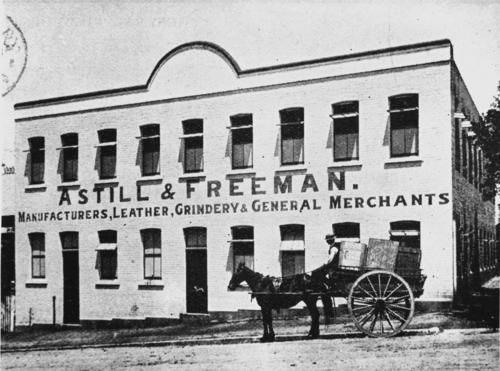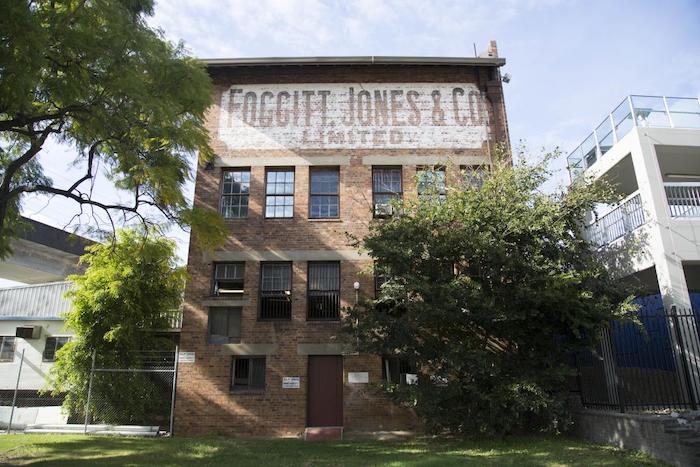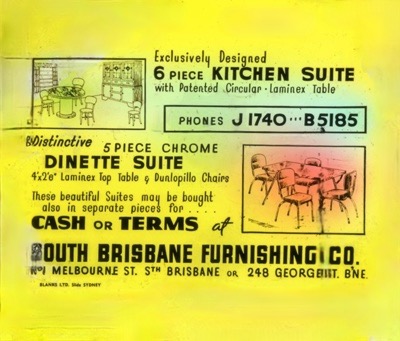‘The Old Boot Factory’
Jolly & Batchelor Premises (former) also known as Astill & Freeman Boot Factory

When Joseph Astill and James Henry Freeman bought a 36 perch site at 17 Cordelia Street in South Brisbane in 1895 they were already well established in the boot making business in Tank Street, Brisbane. A year later they moved to Mary Street and in 1897 had a purpose-built brick factory built at their new site in South Brisbane. It was to become one of the first factories in Brisbane in which mechanisation was introduced.

Bootmaking was an important industry in the 19th and early 20th centuries. In 1888 Queensland imported £179,000 worth of boots and shoes, and there were about 140 boot making establishments in Brisbane, many were individuals working from their home or small workshops. The industry grew rapidly in Queensland, from 18 small boot factories in 1888 to 39 by 1897 employing 1,546 men.
Strong competition with frequent industrial disputes over working conditions and introduction of mechanisation made for a volatile industry. The fourteen-week bootmakers strike from May to August 1895 completely stopped the industry and ultimately forced union members to cave in and accept poor conditions and lower wages in order to survive. Many lost their jobs with mechanisation and boys were often employed to take the place of men.
When Astill & Freeman’s factory opened in 1897 workers were getting 35% below the already reduced rate agreed on after the 1895 strike. However, an increase in domestic manufacture led to a decrease in imports.

After the death of James Freeman in 1893, Arthur Freeman took his place but the partnership ended with his death in 1909. Joseph Astill continued the business as Joseph Astill & Co. Ltd until 1944 when it changed to J & R Astill. In 1964 the business was sold to the leather manufacturing company of Jolly and Batchelor Pty Ltd. They continued trading until the business was again sold in 1994.
Although the building is no longer used as a bootmaking factory, the exposed brickwork, internal posts and beams remain as a reminder of the significance of the industry. It is a simple, functional building with large windows providing light to the factory floor, a metal roof and internal timber floors. The building was entered on the Brisbane City Council Local Heritage Register on 1 July 2002 as an important ” remnant of the leather-making industry which was of great economic importance to both the city and the state in the late nineteenth and early twentieth centuries.” In September 2007 it was spruced up and became the home of Bees Nees City Realty and serviced office businesses. It was aptly named The Old Boot Factory.
(sources: BCC Heritage Register/BCC images/HTTPS://WESTENDER.COM.AU/THE-STORY-BEHIND-THE-OLD-BOOT-FACTORY/)
Foggitt & Jones factory (former), 3 Lanfear Street
The three-story brick warehouse of Foggitt & Jones on the south bank of the river was built ca. 1917 for Foggitt, Jones and Co. producers of ham, bacon and smallgoods which had been established in 1904.

The company was founded by Charles Emanuel Foggitt who emigrated from Yorkshire at the age of 22 and started out working for J C Hutton, producers of ham and bacon located in Oxley. In 1904 he and Thomas Llewellyn Jones bought out Hutton which was struggling financially and founded Foggitt, Jones and Co. The business grew rapidly and within five years had a turnover of £1 million as well as a factory in Freemantle. During the next few years factories were also established in Victoria, New South Wales, Tasmania and South Australia. One of its most popular brands was Rex, especially the camp pie, quality hams, baked beans and luncheon cheese varieties.

Rapid expansion meant that soon more space was needed in Brisbane. In June 1916 the company bought a 25 perch property at the very end of Boundary Street in South Brisbane, an ideal industrial location close to the river and railway. A year later they built a canning factory and warehouse for the popular Rex luncheon cheese. In May 1921 the company changed to a limited company, Foggitt Jones & Co. Ltd. The highly profitable business continued to grow leading to a merger with their old employer J C Hutton Pty Ltd in October 1927 and formation of a holding company United Provisions Ltd. Unfortunately Charles Foggitt did not live to see this milestone as he had died on 13 July 1926 aged 61. Jones continued running the business until his death in 1946. The company then dropped the Foggit Jones brand, changed its name to Huttons and eventually sold its operations. 1932 Advertisement for Rex beans. (Sunday Mail, 17 July 1932)
1932 Advertisement for Rex beans. (Sunday Mail, 17 July 1932)
In 1957 the land was resumed by the Brisbane City Council Railways Commissioner for railway purposes and was then leased to Pauls Ice Cream and Milk which had an adjacent factory facing Montague Road. Pauls was amalgamated into Queensland United Foods in 1960.
The brick warehouse at 3 Lanfear Street next to the Go Between Bridge has three storeys and a corrugated iron roof, plus a basement level at the end facing the river. It was entered on the Brisbane Local Heritage Register on 30 October 2000 as an important remaining example of the area’s early twentieth century industrial development and a largely intact example of a purpose-built, World War I era industrial building. The original sign-writing is still visible on the river-end side of the building. Today it houses the Paul’s milk factory engineering stores.
The Plough Inn, South Bank Parklands
The Plough Inn at South Bank Parklands is one of Brisbane’s iconic hotels. It was built on Stanley Street near the corner of Ernest Street during the height of the economic boom of the 1880s and formed an important part of the Stanley Street streetscape. Stanley Street was the principal commercial thoroughfare in the late 19th century. Its was a popular watering hole for workers at the nearby South Brisbane wharves.

The two-storey rendered masonry building was built in 1885 for Irish publican Daniel Costigan by contractor Abraham James for £3,300, replacing a smaller hotel of the same name built in 1864. Only the overall shape of the original remain.

The design was by prominent architect Alexander Brown Wilson (1857-1938) who also designed other historic houses on the south side: Mowbraytown Presbyterian Church, Leckhampton and Lamb House in Kangaroo Point and the Ann Street Presbyterian Church in the city. A major feature is the ornate front façade.

Over the years the Plough Inn has had three major alterations:
1922: a major extension designed by G. H. M. Addison and Sons and built by Robertson and Corbette). It is believed that a street awning was added at this time.
 1987: major modifications to turn the hotel into a tavern for Expo’88. A complete internal re-fit involved removal of most internal walls, central fireplace and chimney. The front verandah was widened, the rear verandah was extended and windows and doors were replaced.
1987: major modifications to turn the hotel into a tavern for Expo’88. A complete internal re-fit involved removal of most internal walls, central fireplace and chimney. The front verandah was widened, the rear verandah was extended and windows and doors were replaced.

1991-2: a conservation plan was prepared by Bruce Buchanan architects. The interior was fully refurbished and the front verandah was reconstructed.

It’s unique heritage value was recognised when it was entered on the Queensland State Heritage Register on 21 October 1992 for being “historically significant as a rare surviving remnant of the commercial and shipping heart of South Brisbane in the late 19th century.”
(adapted from news articles and State Heritage Register).

Today the historic Plough Inn with its expansive verandahs, beer garden and city views from the upstairs Heritage Room is a very popular part of South Bank and a ‘must do’ for tourists.
The People’s Drapery House
The People’s Drapery House in Stanley Street, South Brisbane was established in 1863 by D. Sinclair and transferred to J.M. Sinclair in 1901. The upper storey of the attractive building has a parapet and a beautiful neo-classical façade. The advertising on the building offers a free bus ride to the dissolution sale.
The advertisement illustrates the wide range of goods available: haberdashery, paper patterns, millinery, drapery, parasols, gloves and hats. It also refers to the change of ownership.

The Montague Hotel (former Coronation Hotel)

The heritage-listed Montague Hotel at 48 Montague Road, South Brisbane was built in 1891 on a corner site on Montague Road in an area close to the growing business and residential centre of South Brisbane. Other businesses in the immediate area included a few fishermen, an ice-cream maker, a tinsmith, a shipwright, two hawkers and a sheep’s trotter seller. Opposite the hotel was Carmichael’s Timber Yard. The West End Brewery was only a block away. The first licencee was George Lotz.
The hotel was designed by renowned Brisbane architect FDG (Francis Drummond Greville) Stanley. As Queensland’s Colonial Architect from 1872 he designed many important buildings of this era including the South Brisbane Municipal Library; the Queensland Club; the former State Library, built as Queensland’s first museum, in William Street; the Port Office building, and the General Post Office.
The two-storeyed rendered and painted brick building has a hipped corrugated iron roof. The distinctive cantilevered iron-lace verandahs and awning over the street give it an attractive street façade. Timber French doors open onto the first floor balcony which has a cast-iron balustrade and galvanised sheet iron columns. The parapet above the awning has a cornice with ornate dentil blocks, a pediment over the corner, and three shaped gables embellished with spheres. A two-storeyed brick service wing with timber verandah extends is attached at the back.

During the 1893 Brisbane floods the new hotel was submerged up to about a metre above the first floor and the verandahs were ripped off by the powerful torrents. The footpaths were washed away, leaving the hotel surrounded by its own ‘moat’ after the water finally subsided. While most other timber buildings in the area were destroyed by the flood, the Montague survived. Flood waters again damaged the ground floor during the less intense floods of 2011.

After the coronation of Queen Elizabeth II on 2 June 1953 the hotel was renamed the Coronation Hotel. From the 1970s the last licencee was Ripper Doyle, a rugby league personality. In 1987 the hotel was bought by the neighbouring QUF for development, but this did not eventuate. During EXPO 88 it functioned as a backpacker hostel.

The Coronation Hotel was entered on the Queensland State Heritage Register on 30 April 1993 in recognition of its significance as one of the last remaining intact buildings complete with ornate timber staircase and lead light windows and a fine example of the work of architect FDG Stanley. For more details see https://apps.des.qld.gov.au/heritage-register/detail/?id=600298
In 1996 major renovations were carried out to the interior with smaller bars operating from the original public bars. The rest of the building was leased to other businesses.
Today it is the home of the Milk Factory Kitchen and bar, a live music venue and is once again known as The Montague offering a “Heritage Pub, live music, great food, beer garden, open 6 days. ” See https://www.themilkfactorybar.com.au
(Sources: SLQ; BCC: Explore the secrets of South Brisbane – Brisbane Heritage Trails; Queensland State Heritage Register).
The Fishermen’s Co-op on Stanley Street
The Fishermen’s Cooperative Co. Ltd was formed in April 1921 and began operating in May 1921 to control the receiving and disposing of fishermen’s catches by auction at the State Fish Markets in South Brisbane. (SLQ)

Shaw and Sons, ironmongers- an Irish immigrant’s success story

The sign on the brick building of this classic photo of Melbourne Street in 1889, Shaw and Sons, ironmongers intrigued me. A little research discovered an interesting story about an Irish immigrant who built up a thriving business emporium. His story is a good example of the commercial progress in South Brisbane at that time.
William Shaw was born in Killyleagh, Northern Ireland and emigrated to Queensland around 1883. He soon established his own ironmonger and hardware business, Shaw and Sons, in Melbourne Street near the Victoria Bridge. The timing was right as South Brisbane was in the midst of an economic boom which lasted from the 1880s to about 1900. This was the start of what was to become a very successful, highly regarded and constantly expanding business.
Within two years the business had outgrown its premises and the company built their own premises in a different part of Melbourne Street, near Manning Street, opposite the Post and Telegraph Office.
All went well until the Great Flood of February 1893! Flood waters reached 19ft inside the building and most of the stock was totally ruined. This photo shows flood levels were high at the top of Melbourne Street, but further along were about 6 inches in one of Shaw and Sons’ shops.  However, William was not one to give up. He called on his Irish strength and determination and relocated the business to Queen Street to premises later occupied by Allan and Stark where it continued to flourish. The firm established a reputation for quality products and excellent service. Gradually more and more departments were added to the original ironmongery with furniture, household and drapery goods, groceries, plumbing supplies, saddlery and agricultural implements.
However, William was not one to give up. He called on his Irish strength and determination and relocated the business to Queen Street to premises later occupied by Allan and Stark where it continued to flourish. The firm established a reputation for quality products and excellent service. Gradually more and more departments were added to the original ironmongery with furniture, household and drapery goods, groceries, plumbing supplies, saddlery and agricultural implements.

By 1904 they had moved to even better premises in the three-storey Royal Arcade with beautiful display windows, electric lights and wide variety of goods. When this became too small they built a new, imposing building known as Granite Buildings with ornate polished granite pillars made of stone sourced from Enoggera. It was the first granite front building in Queen Street.
William Shaw (senior) died at his home in Clayfield on 22 February 1913 in his 71st year leaving five sons and three daughters. He was buried in the South Brisbane Cemetery.
He was acknowledged as one of the “Passing of the Pioneers” in an article in the Queenslander of 8 March 1913. His sons continued in their father’s footsteps expanding the business which he had built up.

They had inherited his entrepreneurial skills and ability to know what the public wanted, they kept up with the times and modernised as needed. One of their many innovations was the establishment in 1923 of what is now known as the ‘bargain basement’ where everything was either sixpence or a shilling. Brisbane shoppers loved this!
South Brisbane Furnishing Company
Looking back at kitchen laminex and chrome tables in this 1950s advertisement for South Brisbane Furnishing Company, 1 Melbourne Street.
This is a photo of a slide of cinema advertising created by Chas Blank shown at the Capitol Theatre Coolangatta and Empire Theatre Tweed Heads.
The Premier Butchery, Stanley Street
The Premier Butchery Stanley Street, South Brisbane was owned by Otto Shuren. The advertisement, in German, was published in the history of the Deutscher Turn Verein (German Club) published on the occasion of the club’s Golden Jubilee in 1933.

The advertisement in English: Otto Shuren – Proprietor, Stanley Street, South Brisbane. Only only first class mutton, pork and veal as well as pickled meat is sold. We give rural orders special attention. Wholesale butchery for maritime supply, etc. (Description supplied with photograph/ State Library of Queensland)

This advertisement appeared in The Truth, 2 April 1939. This time the suburb is given as Woolloongabba.



